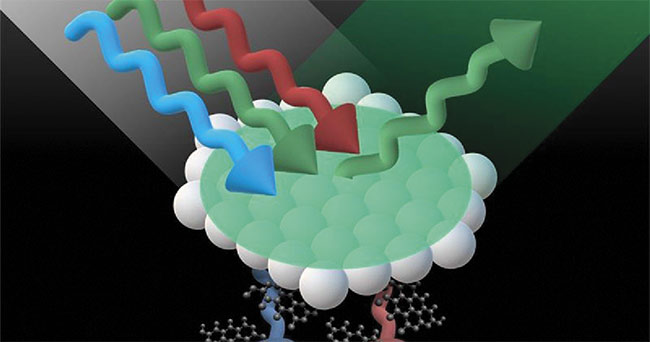It took nature millions of years to develop the tiny scales that give butterfly wings — which are themselves transparent — their intense coloration. Like peacock feathers, they derive their signature hues from structures rather than pigments.

A different sort of butterfly effect is evident
in the development of nanocrystals that produce intense, changeable colors from tiny structures rather than pigments. Courtesy of the University of Surrey.
Now, a team led by scientists at the University of Surrey and the University of Sussex in England has borrowed from nature’s bag of tricks to develop a flexible photonic crystal that can not only display brilliant colors, but also reversibly change them.
The photonic crystals contain graphene — a one-atom-thick crystalline form of carbon — and are created using evaporation-driven self-assembly of soft polymer colloids, according to a paper published in Advanced Functional Materials titled “Mechanochromic and Thermochromic Sensors Based on Graphene Infused
Polymer Opals.”
 The title refers to the feature that makes the opalescent crystals more than a pretty bauble. Their color can respond to light, temperature, strain, or other physical and chemical stimuli, which offers interesting options for cost-effective, robust visual sensors. The sensors appear green under natural light but shift to blue when stretched. They can even turn transparent at higher temperatures. Their crystals act as shape-memory polymers, allowing them to memorize and recover their original shape and color.
The title refers to the feature that makes the opalescent crystals more than a pretty bauble. Their color can respond to light, temperature, strain, or other physical and chemical stimuli, which offers interesting options for cost-effective, robust visual sensors. The sensors appear green under natural light but shift to blue when stretched. They can even turn transparent at higher temperatures. Their crystals act as shape-memory polymers, allowing them to memorize and recover their original shape and color.
The researchers added graphene into a colloidal crystal lattice to form photonic crystals with angle-dependent structural color and a reversible stopband. These unique features make the crystals good candidates for a
variety of visual sensing applications.
Their sensitivity to thermal changes offers a visual indicator when
perishables, such as food or pharmaceuticals, have experienced undesirable time-temperature histories, for example. Their pressure-responsive shape-memory characteristics also enable them to precisely reveal fingerprints, offering new options for biometric and anti-counterfeiting applications. If functionalized with biomolecules, the crystals could enable the creation of highly sensitive point-of-care testing devices for respiratory viruses, offering inexpensive, reliable, and user-friendly biosensing systems.
The crystals’ color can respond to light, temperature, strain or other physical and chemical stimuli, which offers interesting options for cost-effective, robust visual sensors.
The list of possible applications goes on. As Izabela Jurewicz, a lecturer in soft matter physics at Surrey, said: “While these crystals are beautiful to look at, we’re also very excited about the huge
impact they could make to people’s lives.”
It’s clear that nature can serve as a powerful inspiration to scientists, and the functionality of nature’s colorful creatures and materials can be translated into new and exciting technologies today.